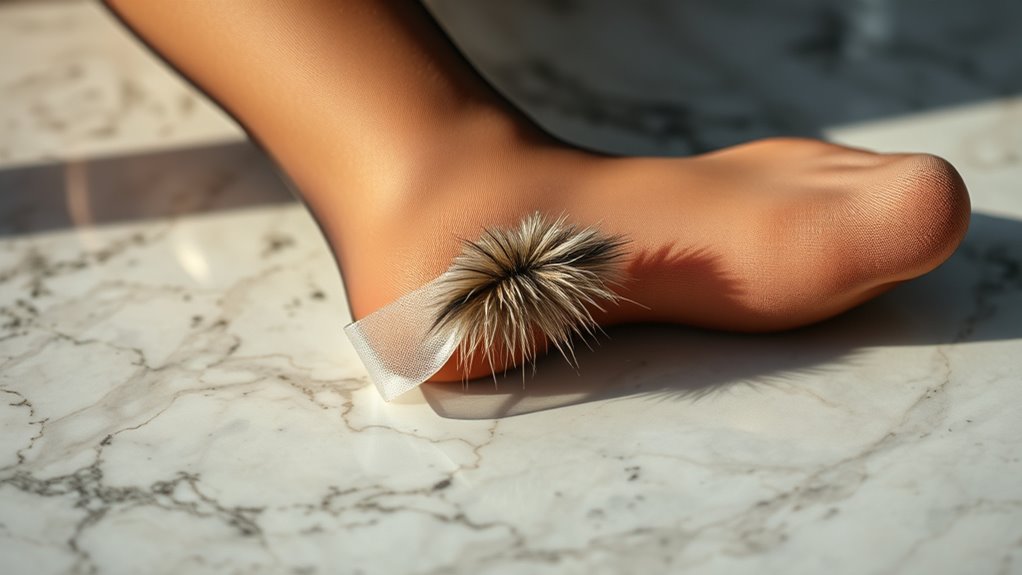The ethics of animal-derived fibers in luxury hosiery revolve around concerns about animal welfare, sustainability, and transparency. While these fibers like silk, wool, and fur symbolize status and tradition, many question their humane sourcing and environmental impact. Certifications and ethical standards are key to making responsible choices. By exploring this topic further, you’ll discover how the industry is evolving with plant-based and synthetic alternatives that aim to balance luxury, ethics, and sustainability.
Key Takeaways
- Ethical concerns focus on humane treatment and welfare standards in sourcing animal fibers like wool, silk, and fur.
- Certification programs and transparent supply chains help verify responsible and cruelty-free fiber sourcing.
- Growing awareness drives consumers and brands to prioritize cruelty-free, sustainable alternatives over traditional animal-derived fibers.
- Legislation and industry standards aim to enforce humane practices, though enforcement varies globally.
- Innovations in vegan and bio-based fibers offer eco-friendly, cruelty-free options for luxury hosiery.
Historical Significance of Animal Fibers in Luxury Hosiery
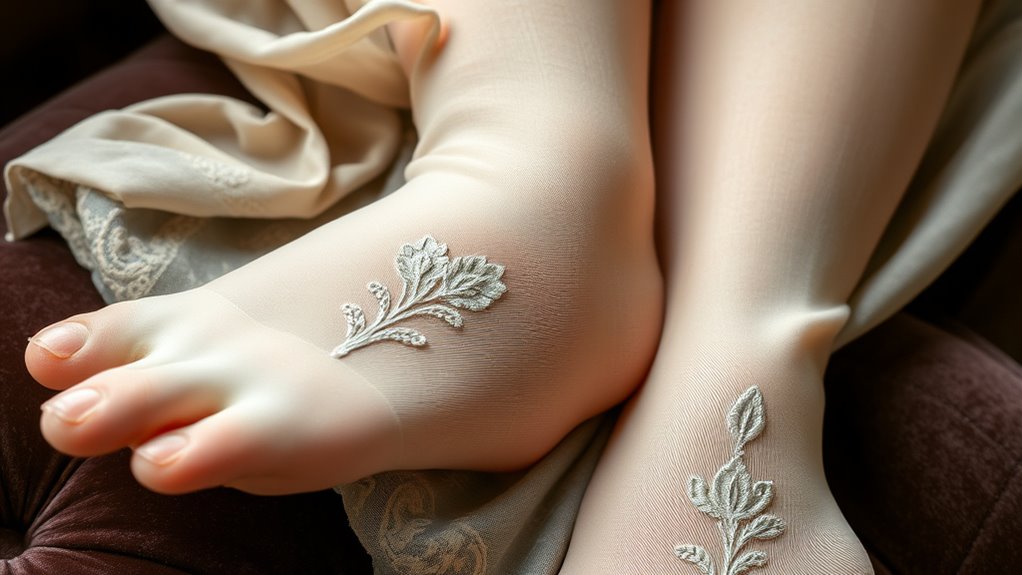
Animal fibers have played a essential role in shaping the history of luxury hosiery, serving as prized materials for centuries. Their historical significance goes beyond practicality, often reflecting status and wealth. In many cultures, fibers like silk, wool, and fur symbolize power, prestige, and tradition. For example, fine silk hosiery was once reserved for royalty and aristocrats, reinforcing social hierarchies. Wool and fur also carried cultural symbolism, representing protection and nobility. These fibers were not just functional; they conveyed identity and social standing. The origins of animal fibers can be traced back to ancient civilizations where they were carefully cultivated, harvested, and woven into garments that signified social hierarchy. As you explore the evolution of luxury hosiery, understanding this cultural symbolism helps you appreciate the deep-rooted values and societal meanings attached to animal-derived fibers throughout history. Recognizing their importance highlights how fashion intertwines with cultural identity and social power.
Types of Animal-Derived Fibers Used in Hosiery Production
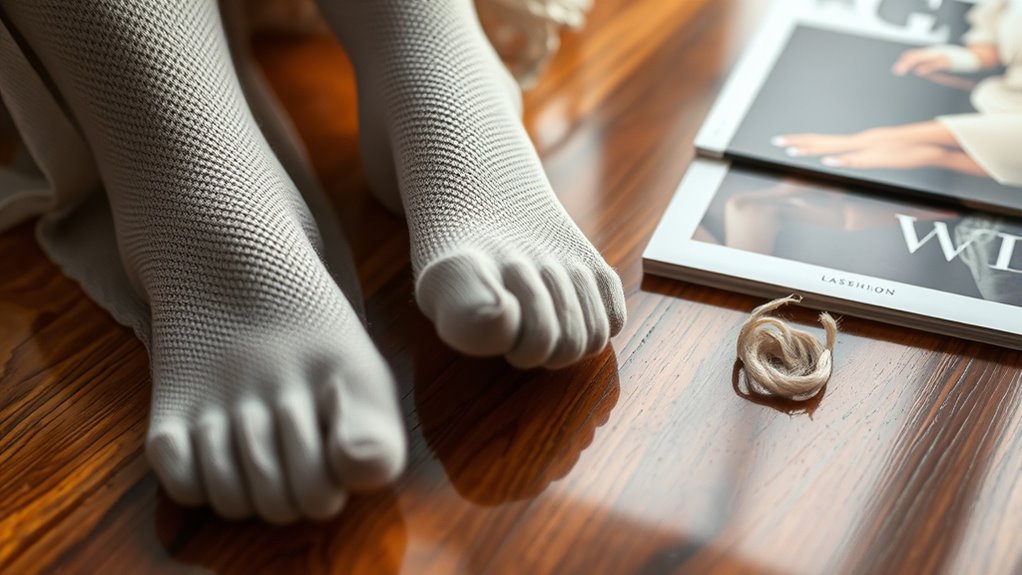
Throughout history, various animal-derived fibers have been valued for their unique qualities and contributions to luxury hosiery. Wool, including merino and cashmere, offers softness and insulation, while silk provides luster and strength. However, concerns around animal welfare have led many to seek vegan alternatives, such as plant-based fibers like nylon, rayon, and bamboo. These synthetic or plant-derived options can mimic the qualities of traditional fibers without harming animals. When choosing hosiery, you might consider whether the fiber’s origin aligns with your values regarding animal welfare. While animal-derived fibers are prized for their natural properties, the growing availability of vegan alternatives offers ethical choices for those who want luxurious hosiery without compromising their stance on animal rights. Additionally, advances in sustainable fiber production are making eco-friendly options more accessible, further supporting ethical consumption.
Ethical Concerns Surrounding Animal Welfare and Sourcing

You should consider how animal welfare standards impact the fibers used in your clothing choices. Ethical sourcing practices guarantee animals are treated humanely and avoid unnecessary suffering. By understanding these concerns, you can make more informed, responsible decisions about the products you support. Additionally, choosing fibers from sources that prioritize animal comfort and well-being can promote better treatment practices across the industry.
Animal Welfare Standards
The ethical concerns surrounding animal welfare and sourcing are at the heart of debates over animal-derived fibers. You must consider how wildlife conservation efforts are impacted by fiber harvesting methods. Poor animal welfare standards often lead to suffering, raising questions about humane treatment and ethical responsibility. In animal rights debates, the focus is on whether animals should be used for luxury textiles at all, especially when their well-being is compromised. Ensuring strict animal welfare standards can help minimize cruelty and protect vulnerable species. Certification programs and regulations aim to enforce humane practices, but enforcement varies globally. As a consumer, you have the power to support brands that prioritize ethical standards, ensuring that animal welfare remains a core concern in fiber production. Additionally, awareness of supermarket hours today can help consumers plan their shopping trips efficiently when purchasing ethically sourced products.
Ethical Sourcing Practices
Ethical sourcing practices directly impact animal welfare and shape the sustainability of fiber production. You should prioritize suppliers committed to humane treatment, ensuring animals are not harmed or exploited. Supporting wildlife conservation efforts helps protect natural habitats and prevents overharvesting of wild populations. When choosing fibers, consider the influence of animal rights activism, which advocates for transparent, cruelty-free sourcing. Ethical practices involve verifying that animals are raised or harvested sustainably and responsibly. This reduces risks of illegal poaching and habitat destruction caused by unethical practices. By demanding transparency and accountability, you help promote a supply chain that respects animal rights and conserves biodiversity. Incorporating digital literacy into sourcing decisions can also enhance awareness of industry standards and certifications. Ultimately, your choices can support a more sustainable, compassionate industry that aligns with conservation and animal welfare goals.
The Impact of Sustainable and Ethical Alternatives

As awareness of animal welfare and environmental concerns grows, sustainable and ethical alternatives to animal-derived fibers are gaining momentum. These options reduce ecological footprints while aligning with your values. By choosing sustainable sourcing, you support responsible practices that minimize harm and promote conservation. Ethical innovation drives new fibers like plant-based, lab-grown, or recycled options, making luxury hosiery more eco-friendly. Here’s a quick comparison:
| Material | Sustainability Level | Ethical Considerations |
|---|---|---|
| Organic Cotton | High | Fair labor, minimal pesticides |
| Tencel/Lyocell | Very high | Sustainable harvesting |
| Recycled Polyester | Moderate | Reduces waste, energy use |
| Piñatex (pineapple leather) | High | Uses agricultural waste |
| Lab-grown fibers | High | No animal harm |
These alternatives demonstrate how sustainable sourcing and ethical innovation can transform luxury hosiery.
Certification and Transparency in the Supply Chain
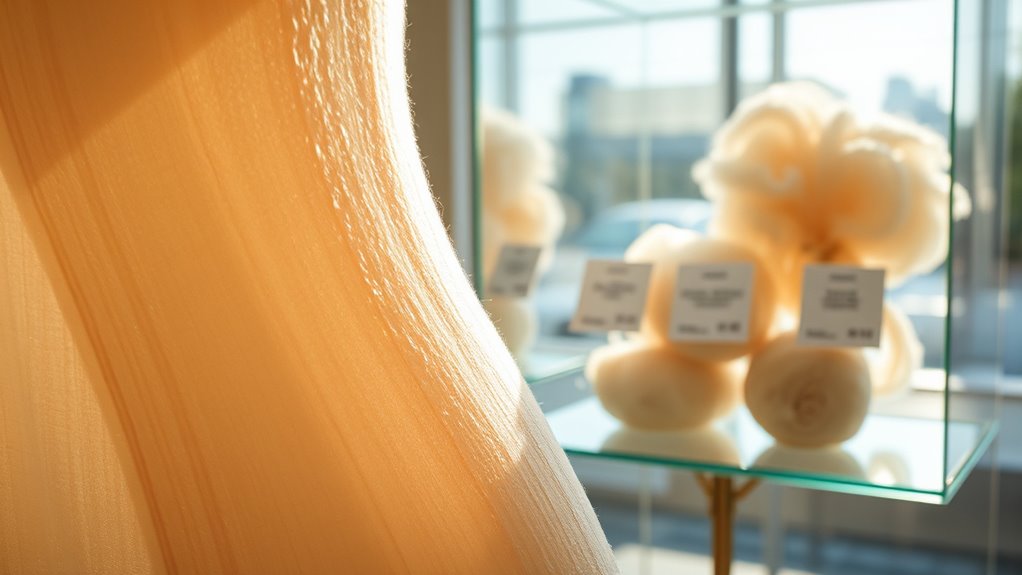
Have you ever wondered how you can verify that animal-derived fibers are sourced responsibly? Supply chain transparency plays a pivotal role here. Certification standards, such as Responsible Wool Standard or Good Animal Husbandry practices, help guarantee fibers come from ethical sources. These standards set clear criteria for animal welfare and environmental impact, making it easier for you to identify trustworthy products. Brands committed to transparency openly share their sourcing information, allowing consumers to trace fibers back to responsible farms and suppliers. By choosing products with recognized certifications, you support ethical practices and encourage supply chains to uphold higher standards. Additionally, understanding the regulatory landscape surrounding animal-derived fibers can help consumers make more informed and ethical purchasing decisions. Ultimately, certification and transparency empower you to make informed decisions aligned with your values.
Consumer Perspectives and Changing Attitudes
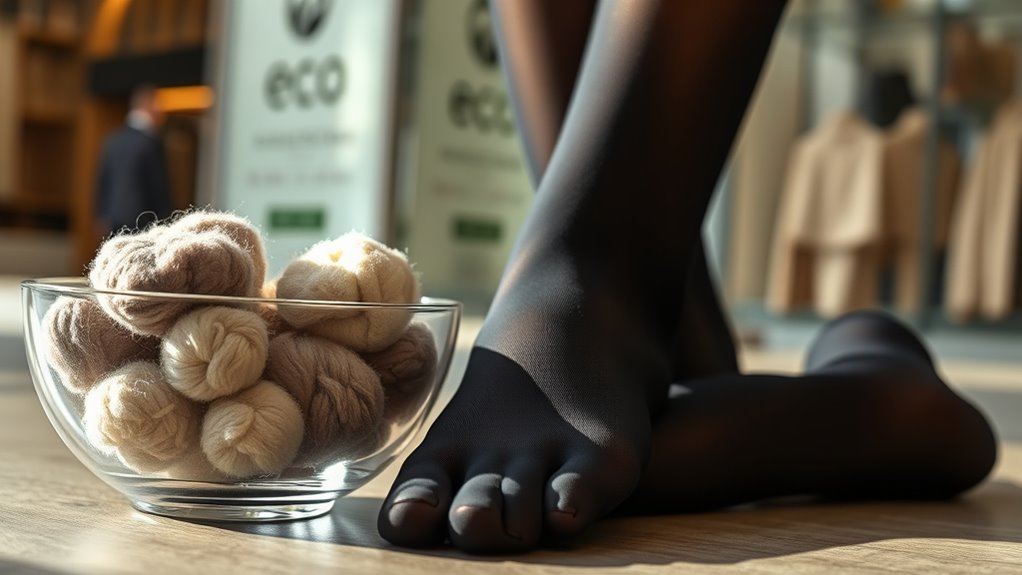
Consumers are increasingly seeking transparency and accountability in the origins of animal-derived fibers, shaping their purchasing decisions. As consumer awareness grows, people pay closer attention to ethical consumerism, demanding products that align with their values. You’re more likely to choose brands that openly share their sourcing practices and avoid cruelty. This shift reflects a broader desire to make responsible choices and support sustainable, humane practices. Many consumers now prioritize ethical considerations over price or status, influencing brands to adapt accordingly. Your awareness of the ethical implications behind luxury hosiery influences your buying habits, encouraging companies to improve transparency and adopt more humane methods. Additionally, certifications and endorsements from beauty experts can serve as indicators of a brand’s commitment to ethical sourcing, further guiding consumer choices. As attitudes evolve, your purchasing power can drive industry change towards more ethical and sustainable fiber production.
The Role of Legislation and Industry Standards
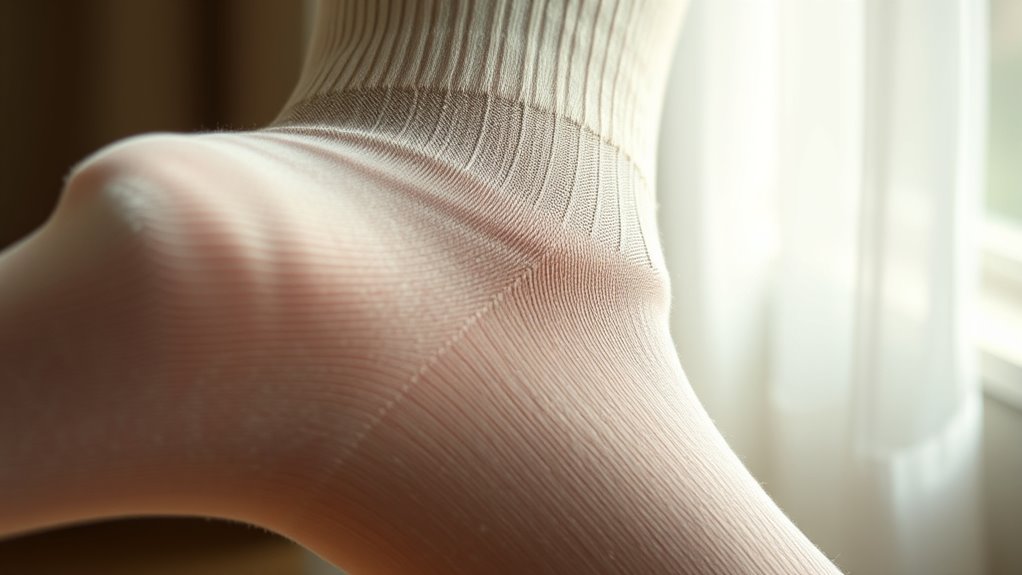
Legislation and industry standards play a crucial role in shaping ethical practices within the animal-derived fiber industry. They set clear guidelines for regulatory compliance, ensuring companies follow humane treatment and sustainable sourcing methods. These laws help prevent unethical practices by establishing minimum standards for animal welfare and environmental impact. Industry oversight, through certifications and audits, holds manufacturers accountable and promotes transparency. When regulations are enforced effectively, they foster consumer trust and encourage responsible production. By adhering to industry standards, companies demonstrate their commitment to ethical integrity, which can differentiate them in a competitive market. Additionally, self-watering plant pots exemplify sustainable design by reducing water waste and promoting plant health. Ultimately, legislation and standards serve as essential tools to align industry practices with societal expectations, ensuring that luxury hosiery products are both high-quality and ethically produced.
Balancing Craftsmanship With Ethical Responsibility
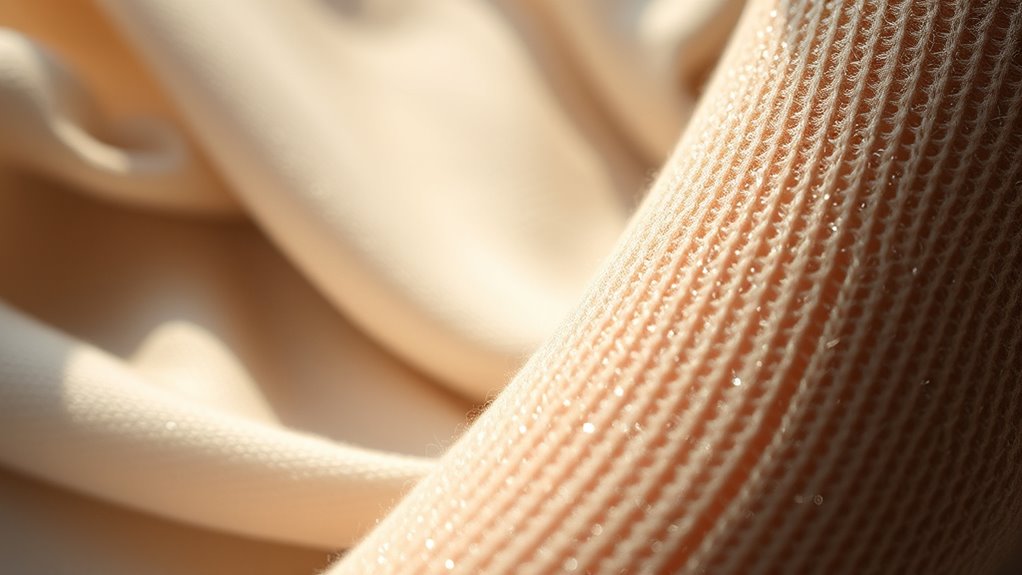
Balancing craftsmanship with ethical responsibility requires artisans and manufacturers to prioritize both quality and humane practices. You must respect wildlife conservation efforts, ensuring that sourcing animal fibers doesn’t threaten species or ecosystems. Preserving the cultural significance of traditional techniques is equally essential; these practices often embody community heritage and craftsmanship passed down through generations. To achieve this balance, you need transparent supply chains and rigorous standards that promote humane treatment and sustainability. It’s about honoring the artistry while minimizing harm to animals and their habitats. By integrating ethical considerations into craftsmanship, you uphold the integrity of luxury hosiery and support broader conservation goals. Implementing testing methodologies ensures quality standards are consistently met throughout the production process. Ultimately, this approach demonstrates that exceptional quality and ethical responsibility can coexist without compromise.
Innovations in Faux and Plant-Based Fibers
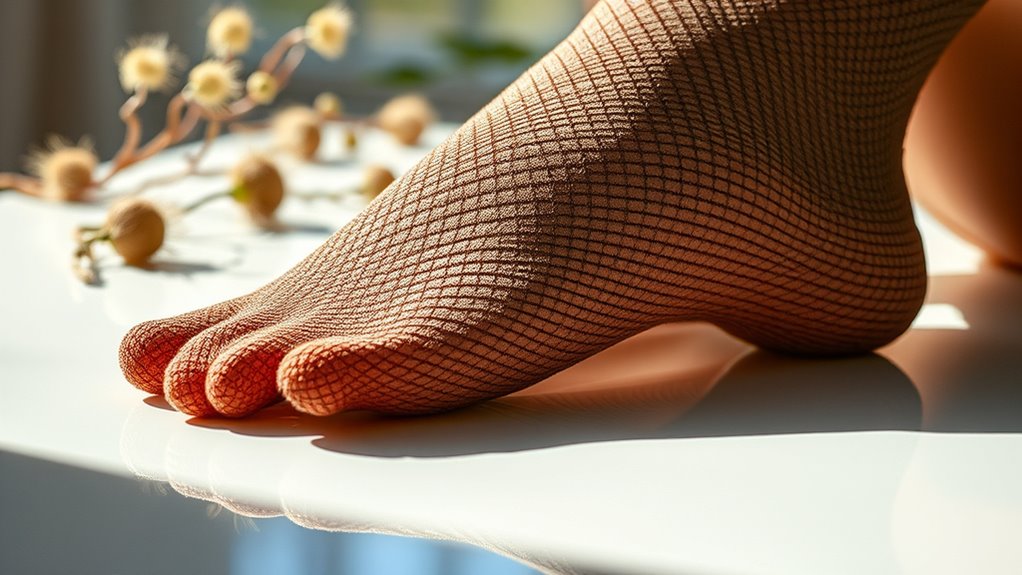
Recent innovations in faux and plant-based fibers are transforming the textile industry by offering sustainable alternatives to traditional animal-derived materials. These fibers address biodegradability concerns, as many synthetic options can persist in the environment longer than natural fibers. Advances in bio-based materials, such as plant-derived nylons and biodegradable polyesters, help reduce ecological impact. Additionally, understanding the chemical properties of these new fibers can guide better manufacturing and disposal practices. However, consumer education is essential to dispel misconceptions and promote understanding of these new fibers’ benefits and limitations. By learning about proper disposal methods and the environmental footprint of different materials, you can make more responsible choices. As technology progresses, these innovations will continue to improve in biodegradability and performance, making plant-based and faux fibers more appealing for eco-conscious consumers seeking ethical fashion options.
Future Trends and Responsible Fashion Practices
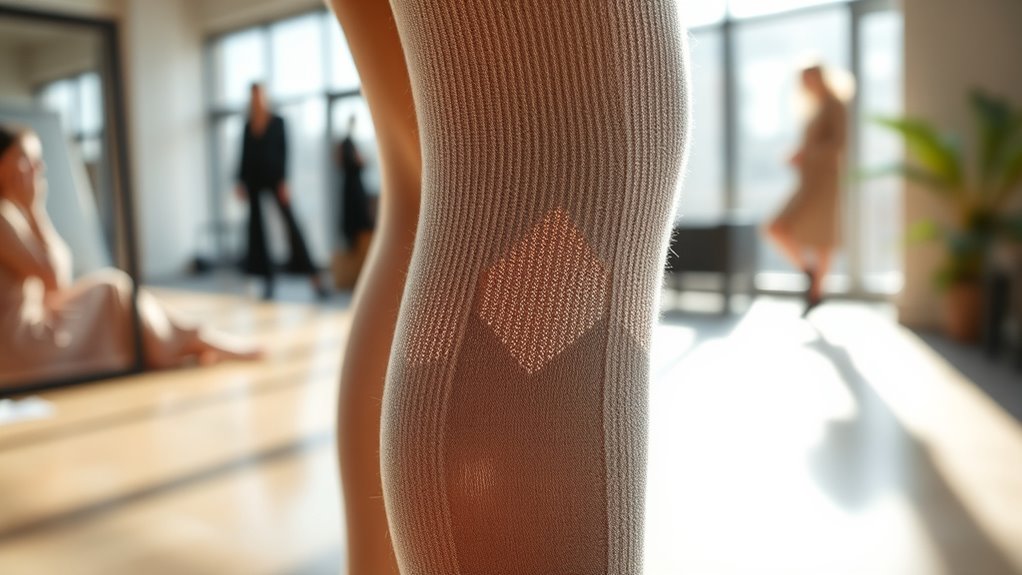
As awareness of environmental and ethical issues grows, future trends in fashion emphasize responsible practices that prioritize sustainability and transparency. You’ll see a shift toward materials with greater synthetic durability, reducing waste and extending product life. Fashion innovation will drive the development of eco-friendly fibers that mimic animal-derived textures without harm. Companies are adopting transparent supply chains, so you can trust where your hosiery comes from. Additionally, brands will increasingly invest in circular fashion models, encouraging recycling and reuse.
- Embracing bio-based and lab-grown fibers for ethical sourcing
- Integrating advanced manufacturing for better synthetic durability
- Promoting transparency through traceable supply chains
- Supporting innovations that blend sustainability with luxury quality
Frequently Asked Questions
How Do Animal-Derived Fibers Affect the Environmental Footprint of Luxury Hosiery?
Animal-derived fibers can markedly increase the environmental footprint of luxury hosiery, due to resource-intensive production and animal farming impacts. You can reduce this footprint by choosing sustainable alternatives like plant-based or recycled fibers. By adopting eco-friendly practices, such as responsible sourcing and minimizing waste, you help lessen environmental harm. Embracing these options supports more sustainable fashion choices, making your luxury hosiery more environmentally responsible without sacrificing quality or style.
Are There Health Risks Associated With Animal Fibers in Hosiery Products?
You might wonder if animal fibers in hosiery pose health risks. While generally safe, there are allergenic concerns for some individuals, especially those with sensitive skin or allergies to wool or silk proteins. Infection risks are minimal but can occur if the fibers aren’t properly processed or maintained. Always check for any skin reactions or irritation and choose products that meet high hygiene standards to reduce potential health issues.
What Cultural or Traditional Significance Do Animal Fibers Hold in Luxury Hosiery?
Oh, surely, wearing animal fibers is just a trendy way to flaunt your cultural heritage and support traditional craftsmanship, right? You get to feel connected to centuries-old techniques, like knitting with the tears of history itself. These fibers symbolize more than warmth—they embody cultural pride and artisanal mastery. So, when you slip into luxury hosiery, you’re not just dressing; you’re honoring a rich tradition, one fiber at a time.
How Do Consumers Perceive Animal Welfare in Relation to Luxury Hosiery?
You’re likely aware that consumer awareness has grown around ethical concerns related to luxury hosiery. Many shoppers now question how animals are treated when fibers like wool or silk are used. This increased concern influences your purchasing decisions, pushing brands to adopt more transparent, cruelty-free practices. You want to support companies that prioritize animal welfare, making ethical concerns a key factor in your choice of luxury hosiery.
What Are the Economic Impacts on Communities Reliant on Animal Fiber Production?
You’ll find that communities relying on animal fiber production often walk a tightrope between economic dependency and sustainability. When demand shifts away from animal fibers, their community livelihoods suffer, risking economic hardship. This reliance can lead to economic vulnerability, making diversification essential. Ultimately, the health of these communities hinges on balancing tradition with innovation, so they can thrive regardless of market fluctuations and maintain their economic stability.
Conclusion
As you walk through a boutique, the shimmering hosiery on display might remind you of centuries-old craftsmanship, yet behind that sheen lies a choice. Just like a delicate silk thread woven into a modern fabric, your decision can connect tradition with ethics. By embracing sustainable alternatives, you shape a future where elegance and compassion coexist—turning a simple purchase into a statement of responsible luxury, much like finding a hidden gem amid everyday choices.
